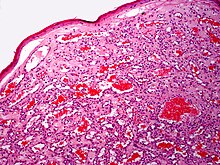Cherry angioma
| Cherry angioma | |
|---|---|
 | |
| A cherry angioma on a person's arm | |
| Specialty | Cardiology |
Cherry angioma, also called cherry hemangioma[1] or Campbell de Morgan Spot,[2] is a small bright red dome-shaped bump on the skin.[3] It ranges between 0.5 – 6 mm in diameter and usually several are present, typically on the chest and arms, and increasing in number with age.[3][4] If scratched, they may bleed.[5]
They are a harmless benign tumour, containing an abnormal proliferation of blood vessels, and have no relationship to cancer. They are the most common kind of angioma, and increase with age, occurring in nearly all adults over 30 years. They were first described by the nineteenth-century British surgeon, Campbell de Morgan.
Signs and symptoms

Cherry angiomas are made up of clusters of
One study found that the majority of capillaries in cherry hemangiomas are fenestrated and stain for carbonic anhydrase activity.[6]
Cause
Cherry angiomas appear spontaneously in many people in middle age but can also, less commonly, occur in young people. They can also occur in an aggressive eruptive manner in any age. The underlying cause for the development of cherry angiomas is not understood.
Cherry angioma may occur through two different mechanisms: angiogenesis (the formation of new blood vessels from pre-existing vessels), and vasculogenesis (the formation of totally new vessels, which usually occurs during embryonic and fetal development).[7]
One study published in 2010 found that a regulatory nucleic acid suppresses protein growth factors that cause vascular growth. This regulatory nucleic acid was lower in tissue samples of hemangiomas, and the growth factors were elevated, which suggests that the elevated growth factors may cause hemangiomas.
A study published in 2019 identified that somatic mutations in GNAQ and GNA11 genes[9] are present in many cherry angiomas. These specific missense mutations found in hemangiomas are also associated with port-wine stains and uveal melanoma. As--the mostly juvenile--Waterhouse Friedrichsen Syndrome is caused by adrenal bleeding from bacterial infections, the 'senile' cherry angiomas may have to be researched for a viral and fungal pathology of the adrenals themselves or of the meninges affecting the adrenals with less dramatic bleeding compared to Waterhouse Friedrichsen's.
Chemicals and compounds that have been seen to cause cherry angiomas are
A significant increase in the density of mast cells has been seen in cherry hemangiomas compared with normal skin.[17]

Diagnosis
The diagnosis is based on the clinical appearance of the lesions. Examination with a dermatoscope shows characteristic red, purple, or blue-black lagoons.
The
Treatment
These lesions generally do not require treatment. If they are cosmetically unappealing or are subject to bleeding angiomas may be removed by
Future treatment based on a locally acting inhibitor of
Prognosis
In most patients, the number and size of cherry angiomas increases with advancing age. They are harmless, having no relation to cancer at all.[23] Eruptive cherry hemangiomatosis has been rarely reported as a heralding sign of multicentric Castleman disease (MCD), multiple myeloma and other lymphoproliferative diseases. [24][25]
Epidemiology
Cherry angiomas occur in all races, ethnic backgrounds, and sexes.[citation needed]
References
- ^ ISBN 9780323712378.
- ^ "Campbell de Morgan Spots (Causes, Symptoms and Treatment)". patient.info. 2022-01-18. Retrieved 2024-02-13.
- ^ ISBN 978-0-323-54753-6.
- ISBN 978-0-7020-6830-0.
- ^ ISBN 978-0-323-37674-7.
- S2CID 6716433.
- S2CID 25150654.
- PMID 21179471.
- PMID 30601876.
- PMID 10188695.
- S2CID 38801029.
- S2CID 6811229.
- PMID 17382390.
- PMID 9871882.
- S2CID 45485034.
- PMID 9828895.
- S2CID 40976538.
- PMID 6630708.)
{{cite journal}}: CS1 maint: numeric names: authors list (link - S2CID 13497344.
- S2CID 43324812.
- PMID 17693661.
- PMID 19026990.
- ^ Perkins, Sharon. "Cherry Angioma & Skin Cancer". livestrong.com. Retrieved 10 April 2018.
- PMID 23426475.
- PMID 23522425.
External links
- eMedicine with picture showing small red dots
- Pereira, José Marcos (2004). "Hemangioma rubi no couro cabeludo". Anais Brasileiros de Dermatologia. 79: 83–89. .
